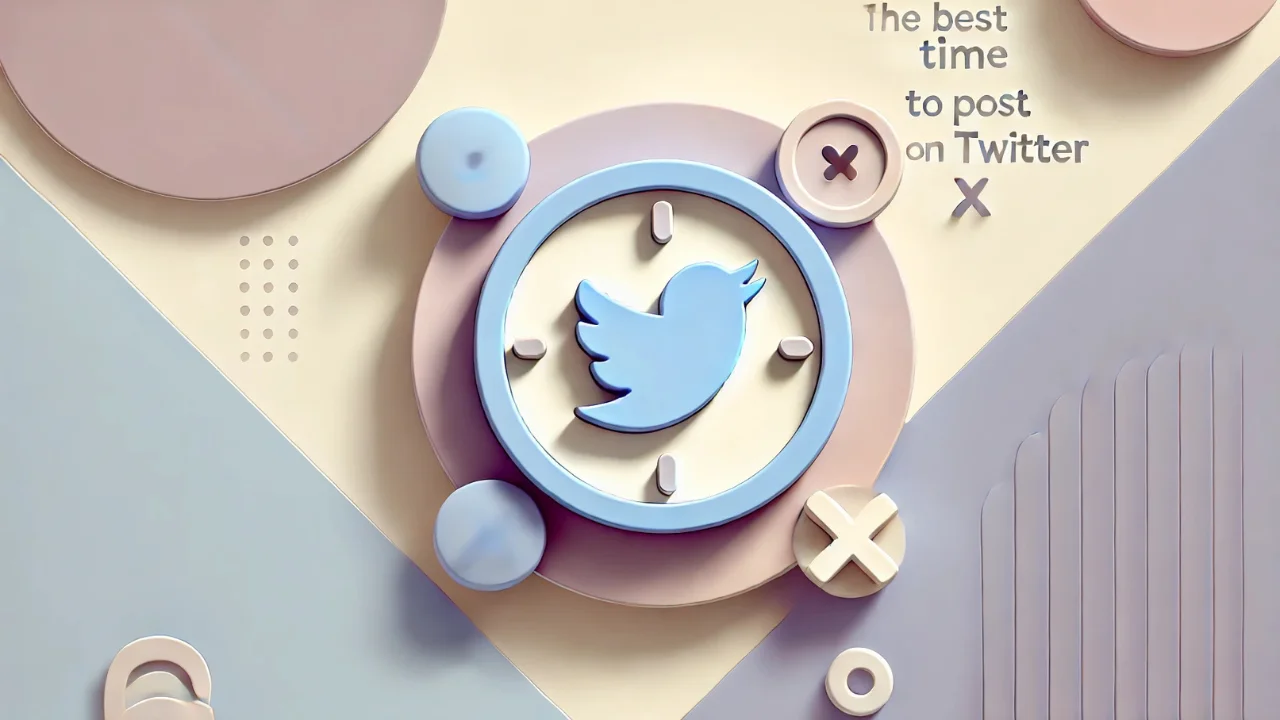Understanding the best time to post on Twitter (X) in 2025 can significantly affect your content strategy. Statistics indicate that more than 6000 tweets are posted every second. It is an extremely competitive field, so it is important to understand how the algorithms work. In this case your posts will become more viral and your audience engagement will increase.
Finding the perfect time to post can be challenging. The window between 9 AM and 11 AM is considered to be the most effective. However, the perfect time varies according to your audience and its behavioral habits. That’s why knowing general trends is just the beginning.
Here we will tell you about what time is most suitable to reach the maximum amount of people. We will also discuss how other factors, such as day of the week or special events, can influence optimal posting time.
Why Knowing the Best Time to Post on Twitter is Important?
By posting at the optimal time on Twitter, the chances that your target audience will see your content increase. This is particularly crucial given Twitter’s constantly evolving algorithms, which can influence the visibility of your posts.
Using analytics like Social Pilot, Buffer, How Sociable, and Track Maven you can gain valuable insights about when your followers are most active. These platforms provide you with deep analysis of your audience engagement, and adapt content plan accordingly with the real needs of your audience. However, it is important to understand that there is no universal optimal time for posting. Twitter’s algorithms and users’ behavioral patterns constantly change. Therefore, strategy planning requires a personalized approach.
Understanding what time is best for publishing not only enhances your posts’ visibility but also optimizes your content marketing strategy. Regular monitoring and adjusting the posting time will help maintain relevance and attract a new audience.
Besides, the right time enables you to manage resources and minimize marketing costs. By regularly updating data and using analytics platforms you can adjust your strategy online and thus improve overall efficiency of your efforts on Twitter and provide max ROI.
Does user activity time depend on the industry?
The best time varies according to business field.
Understanding the specific needs of the users and their behavioral patterns allows you to adjust a particular content strategy and make the most of the platform’s capabilities.
Let’s have a look at the time slots that are considered most effective for different industries.
B2C (Business-to-Consumer)
For companies working in the B2C sphere active time is early in the morning and the evening. From 7 to 9 am is perfect as users start their day and surf their social media.
From 7 to 9 pm users check Twitter after work and they are ready to engage with content. These time intervals provide higher engagement and response rates for ads.
B2B (Business-to-Business)
For B2B companies the optimal time is a bit different. Early mornings, especially from 8 to 10 am, are the most effective. Workers start their day and regularly check Twitter for news and updates in their field.
Posting in the evening from 5 to 7 pm is also a good idea, as users are winding down and more likely to engage with content related to professional development and business.
Software
Tweets posted from 8 to 10 am can attract professionals starting their day.
The time between 8 and 10 pm is also useful for interacting with software developers and technical experts who often explore new tools and technologies.
Healthcare
Here you need to take into account the schedules of medical workers and medical service consumers, depending on what your target audience is.
Doctors and medical workers are often tied to strict schedules and emergency calls and thus check their feed mostly at night.
If we are talking about the healthcare business (private hospitals, aesthetic clinics, and so on) follow B2C segment schedule.
Mass Media
Early mornings and late evenings are key time periods for mass media companies. The time between 6 and 8 AM allows you to reach the audience who is looking for fresh news and updates.
The time between 10 PM and midnight can be efficient, as many users surf Twitter before sleep to catch up on the latest news.
Education
The optimal time to post varies depending on the audience.
The time between 7 and 10 AM is suitable for reaching students and teachers who start their day.
The time between 7 and 9 PM is also useful for reaching those students who may be studying or looking for additional resources after work or classes.
The choice for optimal posting time on Twitter depends on how specific your field is and the behavioral habits of your audience.
Best Times to Post During the Week
Monday
The optimal time for tweets is in the morning, between 10 AM and 12PM, and in the evening between 7 PM and 9 PM.
Morning post reach people planning their week, while evening ones reach those who check social media after work which contributes to more engagement.
Tuesday
The optimal time for tweets is lunch from 1 to 3 PM and late evening from 10 PM to midnight.
Tuesday is considered the hardest workday. Usually there are lots of tasks, calls and urgent errands. That’s why the audience’s active time is limited by breaks and late evenings.
Wednesday
On Wednesday, it is better to post between 10 AM and 12 PM and from 5 to 7 PM.
Morning posts are useful for users who are into new content and evening posts target those who scroll their feed after a busy day.
Thursday
The perfect time to tweet on Thursday is between the afternoon and 4 PM and from 10 PM midnight to.
Users are preparing for the weekend and thus they are more available in the afternoon and before sleep.
Friday
On Friday, it is better to post at 11 AM and 8 PM.
Morning posts target those who plan their weekend and look for interesting content. Evening posts are more effective to attract those who finish their workweek and are ready to relax.
Since users tend to scroll their social media more often on Fridays in search of entertainment and weekend plans, posts published at these periods can achive a higher level of engagement. Considering that Friday is the transition from work to leisure, it is strategically important to take these time slots into account.
Saturday
Posting at 10 AM and 8 PM is ideal.
Morning posts reach those who scroll their feed after starting their weekend, looking for something interesting. Evening posts target those who relax at the end of the day.
On Saturdays people relax and go to social events. It is important to publish during these times in order to max visibility and engagement, since your audience is most active.
Sunday
Posting at 11 AM and 8 PM is ideal. On Sundays people also relax and plan the following week. That’s why publications at the mentioned time can attract more users and boost engagement. Since people actively scroll their feeds on Sundays, it is strategically profitable to post at these time slots as it contributes to a higher level of engagement.
How Twitter Analytics can help you
Twitter Analytics helps you understand which tweets are perceived by the audience. You can track views and find out how much your content attracts and how much it is efficient in terms of reach.
You should use Twitter Analytics to:
- Evaluate your engagement level. Content creators can see how many interactions (likes, retweets, comments) every tweet gets and determine which topics and formats are met with the most interest.
- Optimize content strategy. For example, you noticed that particular types of posts and topics are more interesting to your audience, and you can focus on them in the future, enhancing the overall effect of your publications.
- Schedule posts. Platforms like Social Pilot and Onlypult, working with Twitter Analytics data, allow you to make an optimal posting schedule. By knowing when your audience is most active and what types of content contribute to the most engagement, you can schedule posts to maximize effectiveness.
- Analyze trends. Twitter Analytics helps determine seasonal trends and engagement patterns, which allows you to adapt your strategy and use trend topics to work in your favor.
- Improve marketing strategy. Understanding which content works best allows you to spend money on marketing more efficiently and achieve your main objectives.
- Monitor competitors. By analyzing your competitors’ data, you can understand how your activity on Twitter compares to other companies and find ways to stand out.
Your work with Twitter Analytics and tools such as Social Pilot and Onlypult helps you not only with content management but also with strategic planning.
How Onlypult can help you with Twitter
Schedule tools like Onlypult play a key role in optimizing activity on Twitter. There are certain advantages that can help you to manage your content effectively and increase audience engagement.
Scheduling. With Onlypult you will always follow your strategy and consistently publish posts. Moreover, everything you scheduled will be in one place.
Experiments. Test different times and types of content. This allows you to find optimal time slots for publications, increasing their efficiency and audience engagement.
Analysis and adjustments. By analyzing your engagement level and audience interactions, you can adjust the schedule and content strategy in order to achieve the best results.
Automatization. This feature helps maintain presence on Twitter without the need for daily manual management. This saves you time for other important tasks.
Conclusion
There is no right answer to the question of the best time to post on Twitter (X). The most suitable time depends on many factors, including the uniqueness of your audience, content type, and even seasonal trends.
- It is essential to analyze your audience. Analytics tools like Twitter Analytics provide valuable information about when users are most active. Using these data, you can adjust the posting schedule and settle on the most useful time intervals.
- In addition, such tools as Onlypult play the key role in the time optimization of your publications. They also allow you not only to make a schedule, but also to experiment with various time slots and types of content.
- Last but not least are the regular reviews and schedule adjustments. Audience preferences can change, so it’s vital to stay flexible and be ready to adapt. By using social media calendars and analyzing engagement level, you can keep up with the relevance of your content and reach max efficiency.
In the conclusion, to define the best time to post on Twitter you need to combine data analysis, tests, and strategic planning. This also requires a system approach and all the available tools in order to significantly increase audience engagement and improve the results of your social media strategy.





